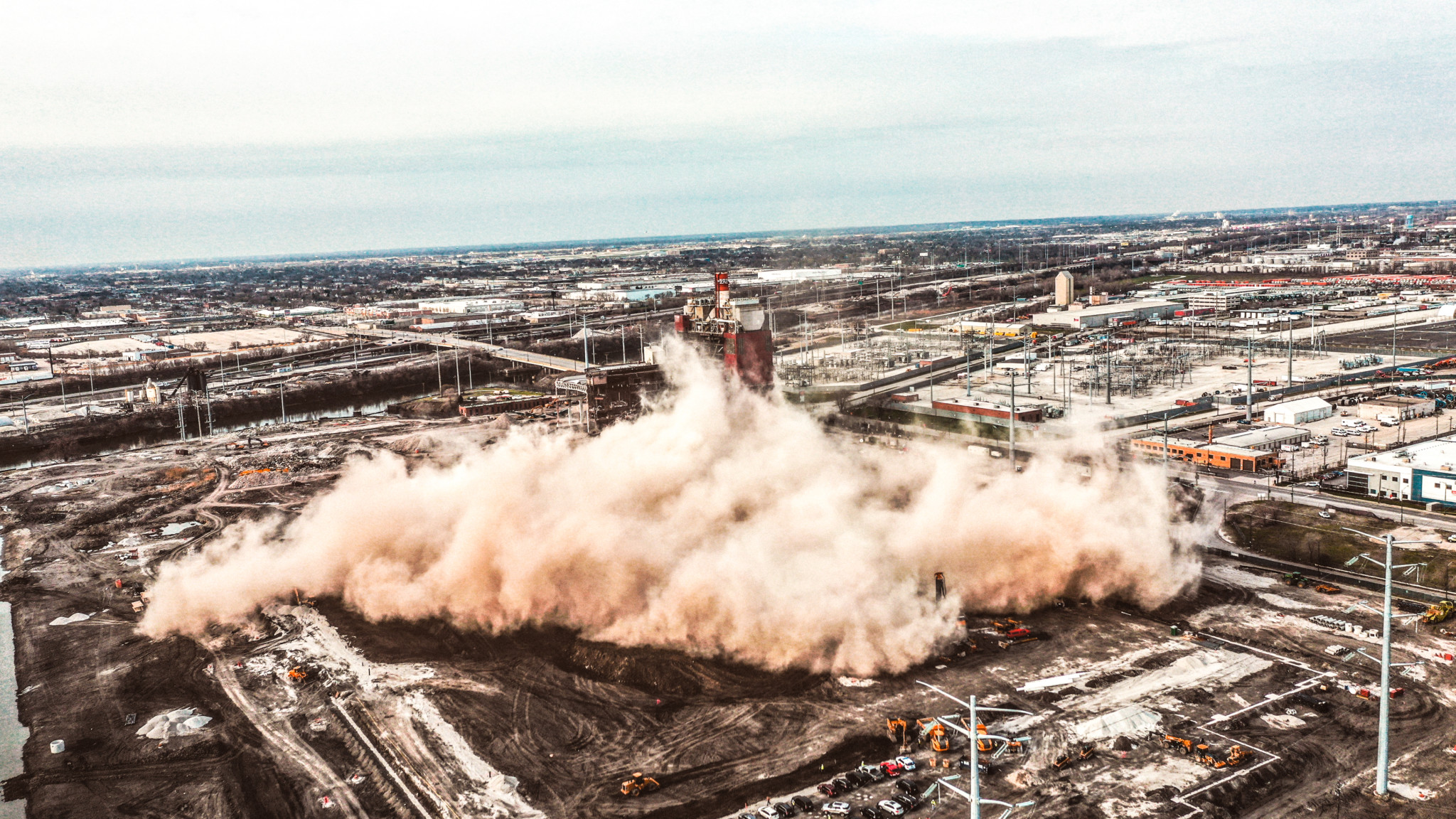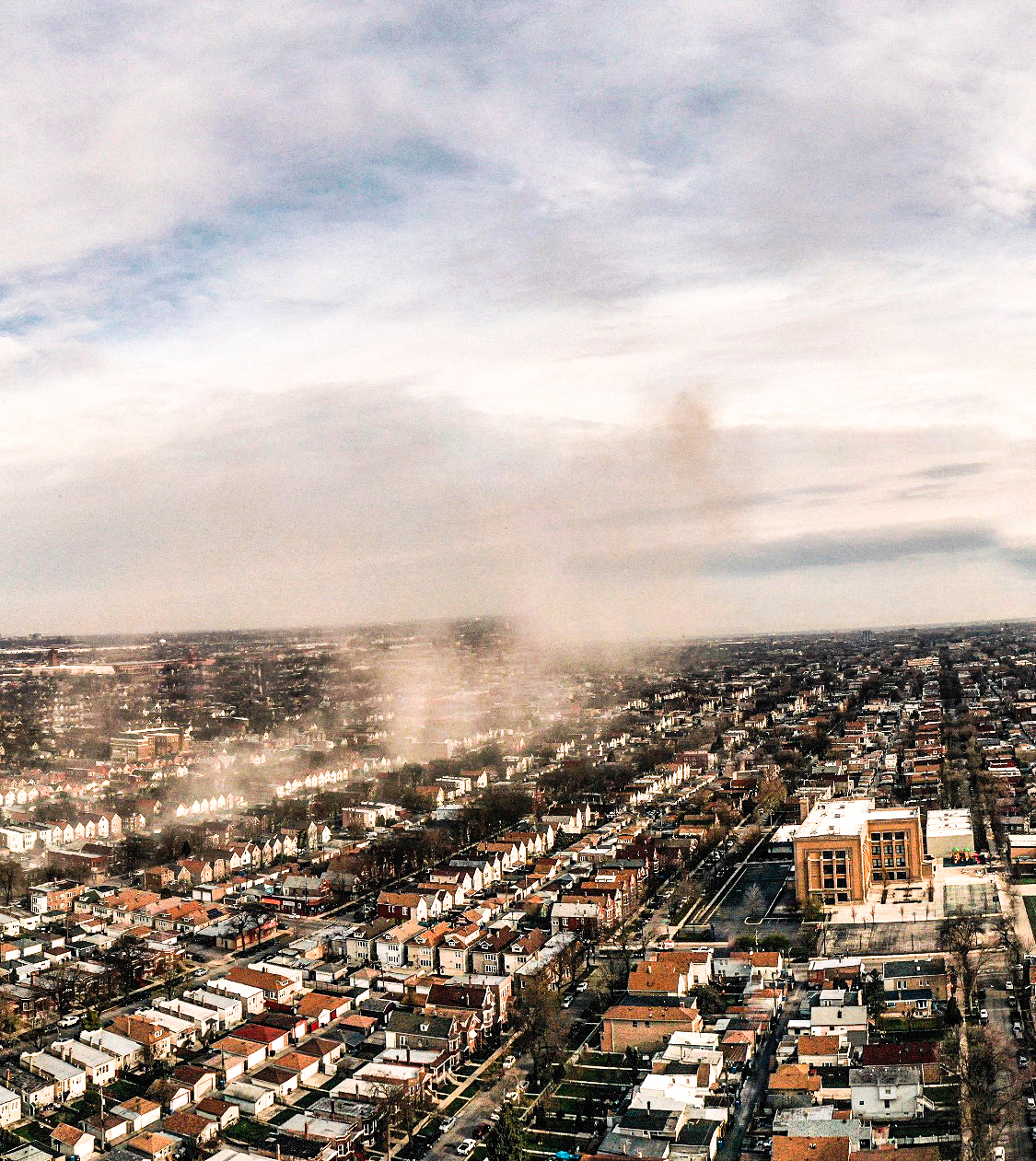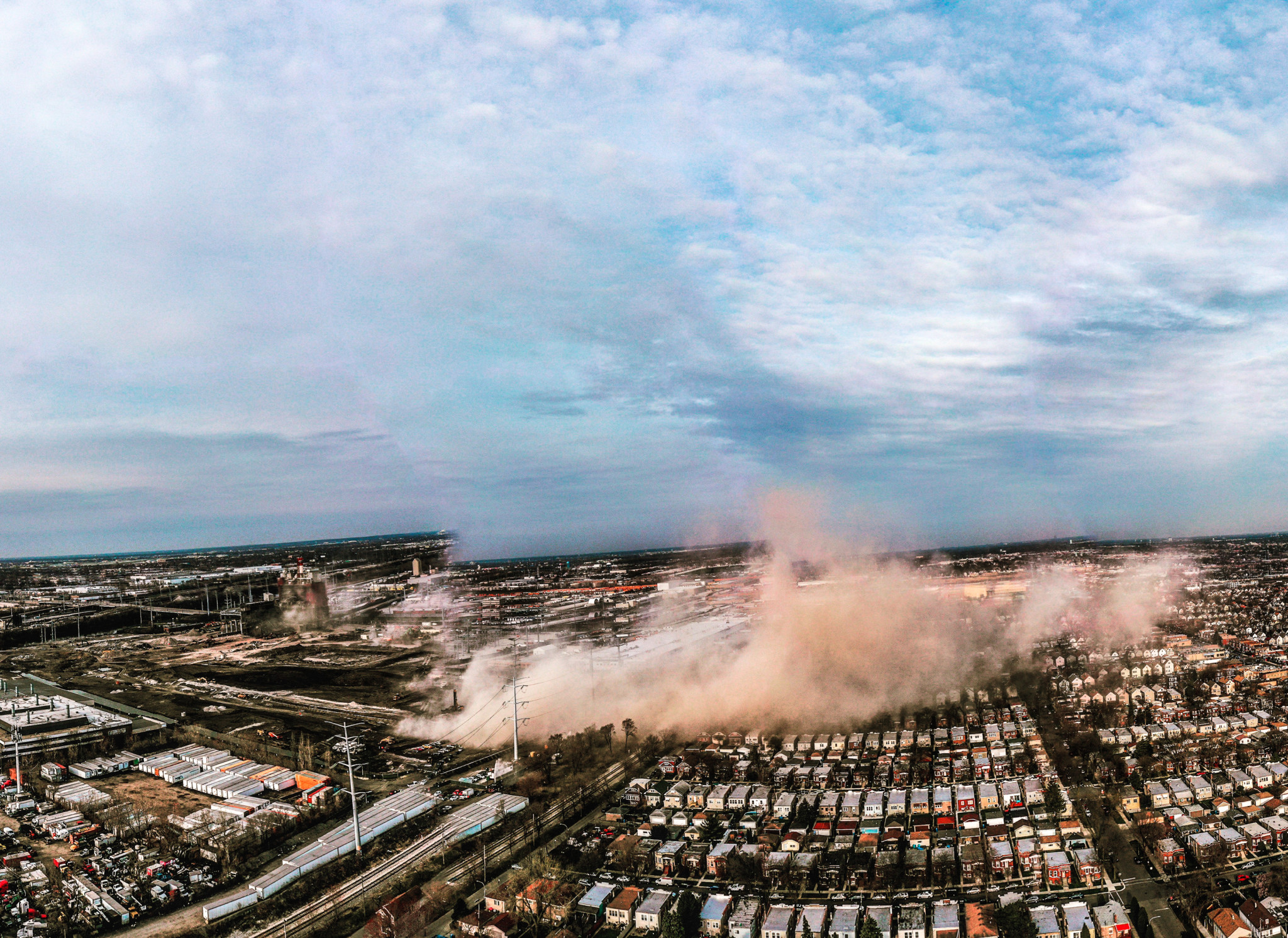Once immortalized in Upton Sinclair’s 1906 novel The Jungle, the meatpacking factories that made Chicago “hog butcher for the world” and gave Back of the Yards its name left the city nearly fifty years ago. But the scent of industry still lingers.
“There’s a saying in Back of the Yards,” says Billy Drew, co-founder of Neighbors for Environmental Justice. “‘It’s not just a place. It’s a smell.’”
Though the Union Stockyards closed in 1971, the working-class Southwest Side neighborhood is flanked by railyards to the east and south, where idling trains emit diesel exhaust fumes that increase the likelihood of cancer by a factor of ten, according to the Chicago Reporter. “For people who have grown up here, it’s part of the environment, being surrounded by industrial pollution,” Drew says.
In neighboring McKinley Park, complaints of nausea, headaches, and asthma have increased following the construction of the MAT Asphalt plant in 2018. Many residents have reported seeing trucks carrying asphalt without tarps, allowing dust to radiate into the air. MAT maintains that the plant is environmentally friendly and operates well under the legal limits for carbon dioxide and particulate matter (hazardous dust particles). Disputing this account are the residents, who have lodged 160 complaints of odor and visible smoke, among other violations, according to WTTW.
For people who live in the shadow of industrial pollution, there is no worse time for a pandemic.
On March 20, Governor J.B. Pritzker announced a stay-at-home order in Illinois due to the outbreak of COVID-19. Though the virus can besiege even the healthiest immune system, regardless of race or class, early reports show that communities of color in Chicago are disproportionately harmed. An analysis from WBEZ found that seventy percent of the eighty-six people confirmed to have died from COVID-19 in Chicago were Black, despite African Americans only making up twenty-nine percent of the city’s population. (Numbers for Latinx residents are still unclear, as it appears the medical examiner’s office may have counted many as “white.”)
Experts in public health generally agree that your health isn’t just based on your genetics and personal choices. It’s also based on extenuating factors known as the “social determinants of health,” which the World Health Organization defines as “conditions in which people are born, grow, work, live, and age, and the wider set of forces and systems shaping the conditions of daily life.”
“Where you live has a huge influence on your overall health,” explains Dr. Susan Buchanan, clinical associate professor of environmental and occupational health sciences at the UIC School of Public Health. “And not just in terms of the environment—the air you breathe—but also in terms of the other stressors going on in the area where you live, including food deserts, violence, lack of decent sanitation, and lack of sufficient housing.”
In Chicago, African Americans and Latinos experience greater rates of poverty and live in neighborhoods that receive a fraction of the investment that majority-white neighborhoods do. They are also far more likely to live in close proximity to industrial pollution and more likely to have asthma, according to the Chicago Department of Public Health. A difference in ZIP code can result in a life expectancy difference as large as thirty years.
All of these factors contribute to higher rates of asthma, obesity, diabetes, stroke, depression, cardiovascular disease, and other ailments, Buchanan says. And since COVID-19 is a respiratory disease that causes pneumonia, existing pollution can aggravate the situation. “If you live in an area where the air quality is poor, your lungs are already going to be stressed, so you may be at higher risk of COVID-19.”
For people breathing polluted air, respiratory illnesses can be even more deadly. In 2003, Chinese patients with SARS, a similar species of coronavirus, were twice as likely to die from the disease if they lived in an area with high air pollution, according to a study published in the journal Environmental Health. A preliminary study from statisticians affiliated with Harvard’s T.H. Chan School of Public Health that is still undergoing peer review found that, as of April 4, a small increase in particulate pollution is associated with a fifteen percent higher death rate from COVID-19.
Juliana Pino, policy director for the Little Village Environmental Justice Organization, has noticed the health effects of industrial pollution in the majority-Latinx community—and she sees the issues as intertwined. On March 11, Pino tweeted, “#coronavirus and #COVID19 are an #environmentaljustice issue. Where do you think thousands of elders with compromised immune systems, respiratory and heart diseases, and other so-called ‘co-morbidities’ caused by pollution + racism w ‘higher risk’ live?”
Known for helping shut down the Crawford and Fisk coal plants in 2012, LVEJO has quickly shifted its organizing priorities to COVID-19 education and rapid-response work, such as checking on seniors, offering transportation to medical appointments, and compiling public health resources in both Spanish and English.

On April 11, Hilco Redevelopment Partners demolished a smokestack at the defunct Crawford Power Generating Station in Little Village, sending billowing clouds of coal dust—nearly a hundred years’ worth—into a neighborhood already experiencing the brunt of pollution-induced illness.
“Demolition of large structures near residences needs to be carried out with the utmost of care to control dust emissions. Dust from older facilities may contain many harmful substances including lead, mercury, PCBs and other carcinogenic chemicals,” Buchanan says. Hilco denies that lead and asbestos were spread in the demolition, but did not provide evidence, according to Block Club.
Residents say they weren’t given proper notice by Hilco or 22nd Ward Alderman Mike Rodriguez of the demolition, which is expected to pave the way for a 1.2-million-square-foot Target warehouse and distribution facility that will bring dozens of diesel trucks a day into the neighborhood. As a result, LVEJO has demanded that the city stop the ongoing demolition of the plant, and that the Cook County Assessor’s Office rescind the $19.7 million tax break that Hilco received in 2019. The city has moved quickly, with the mayor issuing a stop-work order later that day.
The potential health impacts of the demolition worsen the already precarious situation that many Little Village residents are in.
“[Neighbors] are really concerned about safety at home and at the workplace,” Pino told the Weekly. In Little Village, some street vendors are only making $20 per day, according to ABC 7, so they can’t afford not to work. Others work in “essential” industries, such as food service, construction, and warehouse distribution, where hours are long and social distancing measures are not being enforced.
On top of that, many people do not have access to masks, gloves, and cleaning supplies and, due to water shutoffs that occurred during the Emanuel administration and have continued into Lightfoot’s, aren’t even able to wash their hands, Pino says. “The pandemic is really just doubling down on these communities and causing additional harm, where folks were in public health emergencies already.”
Incarcerated people at the Cook County Jail, one of the largest single-site jails in the United States, are also at severe risk. As of April 12, 306 detainees and 218 staff members have tested positive for COVID-19, according to the Cook County Sheriff’s Office. Hygienic measures are virtually nonexistent due to shortages of personal protective equipment and, as a result, criminal justice reformers have called for a mass release of detainees who are only there because they can’t afford bail.
Because the jail is located in Little Village, incarcerated people have been similarly susceptible to industrial pollution. Pino says, “They’re breathing the same air, so you can assume that those folks are also impacted by respiratory distress.”
Furthermore, say environmental justice organizers, the problem of pollution may worsen during the pandemic. On March 26, the federal EPA suspended enforcement of environmental laws, waiving regulations on chemical plants, oil refineries, and all other corporations for the foreseeable future.

Locally, Neighbors for Environmental Justice saw an Illinois EPA hearing for the MAT Asphalt plant, planned for March 23, postponed until further notice due to the COVID-19 outbreak. The community meeting was intended for public comment on the IEPA’s draft of a ten-year operating permit for MAT, but with no date on the books, it could take several more months to decide the fate of the plant, which continues to operate despite its expired construction permit. Like LVEJO, Neighbors for Environmental Justice is looking to do mutual aid work for its neighbors in McKinley Park, Brighton Park, and Back of the Yards.
To be able to weather the pandemic, the city will need to do more than tell people to stay home, says Pino. In addition to decarceration in jails statewide and turning on water access for those whose utilities have been shut off, Pino believes the city needs to tailor the COVID-19 response for the city’s least protected communities.
“I think we need to see detailed guidance for communities like Little Village, where you have pollution consequences and higher levels of respiratory distress, [on] access to care under the pandemic and best practices for cohabitation and collective living that are translated in all of the languages where that would be applicable,” Pino says, mentioning that many immigrant households are multigenerational. “That’s really important, this can’t just be in English.”
Pino also supports “priority access to testing” for people with preexisting health conditions, suspending immigration enforcement, and sending stimulus money to all Chicagoans, “whether they’re undocumented or not.”
Of these demands, the city has only responded to the testing component so far. On April 6, Mayor Lightfoot announced the creation of a “racial equity rapid response team,” which will deploy street outreach workers usually used to prevent gang violence to perform wellness checks on people over fifty and those with underlying health conditions on the South and West Sides.
“Supports will include symptom monitoring, testing and pro-active health care engagement,” the mayor said in a press conference. “This team will be integrated into the city’s emergency operations center just as all of our other working groups have been fighting day and night to fight this disease.”
As of publication, the city had not responded to requests for information about whether the city was deploying additional resources specifically to neighborhoods with high rates of air pollution or of asthma and other respiratory illnesses. Twenty-fifth Ward Alderman Byron Sigcho-Lopez and 2nd Ward Alderman Brian Hopkins have called on Governor Pritzker and Mayor Lightfoot to suspend operations at scrap metal shredders in Pilsen and Lincoln Park.
To push forward this agenda, LVEJO has partnered with multiple organizations, including the Southeast Environmental Task Force, Neighbors for Environmental Justice, People for Community Recovery, Organized Communities Against Deportation, and the Chicago Community Bond Fund. Currently, however, opportunities for in-person organizing are limited, if not impossible.
Dr. Buchanan has seen the effects of COVID-19 firsthand as an occupational medicine physician working at the UIC employee health clinic. Unfortunately, being forced to stay inside also presents a health issue for people living under industrial pollution, because indoor air can be more hazardous than outdoor air under normal circumstances, Dr. Buchanan says. When there is no air exchange in the home, “toxins build up because they can’t get out, and [if] you’re sitting many more hours inside your home, you might notice health effects that you didn’t notice before.” Combined with outdoor air pollution, which prevents many from safely opening their windows, it’s a no-win situation for many Chicagoans.
To mitigate potential respiratory irritants, Dr. Buchanan recommends reducing use of space heaters and stovetop ranges (or cracking a window if those are necessary), as these appliances emanate particulate matter that could upset people with asthma. Dr. Buchanan also recommends cleaning any mold in the home with bleach solutions (not more than ten percent concentration) and using nontoxic chemicals for cleaning and pest control (the EPA’s “Safer Choice” label is a reliable guide).
Following CDC guidelines and practicing social distancing are important, but enacting policies to protect the most vulnerable will go further in the fight for environmental justice, she says. She recommends pushing federal and state representatives to pass policies like sick leave and childcare support, especially for gig workers.
“I just want to make sure that people stay home and stay healthy and maintain their activist ideals, so we can get back in the streets once this pandemic passes.”
Taylor Moore is a freelance journalist who has written for VICE, CityLab, Chicago magazine, Chicago Reader, and other outlets. She last wrote about Bridgeport’s Big Boss Spicy Fried Chicken for the Weekly and can be found on Twitter at @taylormundo.


Thanks for writing